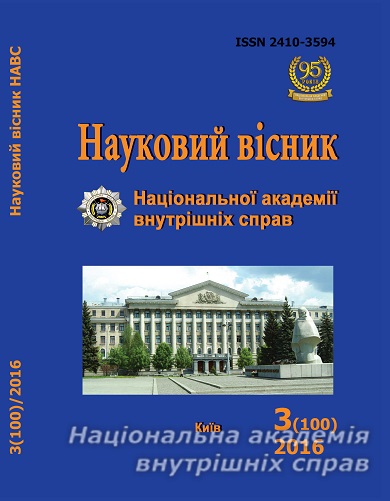Criteria of Delineation of Resistance from other Related Encroachment
Keywords:
resistance, related corpora delicti, delineating signs, qualification, competition of rules, special and general rule
Abstract
The Criminal Code of Ukraine contains a number of corpora delicti that have close or similar signs as to their content. Among them are those that match according to objective or subjective signs the corpus of resistance a state power representative, law enforcement worker, public executive, a member of civic association on protection of public order and state border or serviceman, authorized person of the Deposit Guarantee Fund for individuals. This circumstance makes it necessary to distinguish between different corpora delicti while choosing the law rules on criminal responsibility. However, the current legislation does not contain provisions that would regulate the procedure of application of criminal law, including the qualification. Therefore the problem of establishing common and delineating elements of crime exists under Art. 342 of the Criminal Code of Ukraine along with other related encroachment. This is relevant both for the doctrine of criminal law and law enforcement practice. The article aims to establish corpora delicti which have signs similar to those established for corpora delicti under Art. 342 of the Criminal Code and, in this regard, creating difficulties for the subjects of law in the choice of a law rule along with the criteria for its distinction. To achieve this goal some problems are being solved which are related to the search and analysis of legal and doctrinal approach to the definition of criteria that can establish common and delineated signs concerning the resistance and related offences. The work focuses on the fact that Articles 342, 349, 391, 392, 393, 402 of the Criminal Code provide the related corpora delicti. However, Art. 342 of the Criminal Code, in its application, is also in the ratio with competing rules. Therefore, in order to determine what rule is applicable, it is necessary to clarify how these competing rules are subject to each other. The research made it possible to formulate a conclusion that the corpora delicti contained in Articles 349, 391, 392, 393, 402 Criminal Code, correlate with the corpus delicti under Art. 342 as related. It is characteristic for these corpora delicti that they are different from the corpus of resistance by several objective and subjective signs, but at the same time being related with others. Because of the incompatibility of content signs, which differ abovementioned corpora, there is reason to determine these signs as those being delineated. As to corpora delicti we can consider them as being related.Downloads
Download data is not yet available.
Abstract views: 96 PDF Downloads: 22
How to Cite
[1]
Habuda, A. 1. Criteria of Delineation of Resistance from other Related Encroachment. Scientific Herald of the National Academy of Internal Affairs. 100, 3 (1), 207-216.
Issue
Section
Theoretical problems of jurisprudence
- Authors reserve the right to authorship of their own work and transfer to the magazine the right of the first publication of this work under the terms of the Creative Commons Attribution License, which allows other persons to freely distribute published work with mandatory reference to authors of the original work and the first publication of an article in this magazine.
- Authors have the right to enter into separate additional agreements on non-exclusive dissemination of the work in the form in which it was published in the journal (for example, to post an article in the institution's repository or to publish as part of a monograph), provided that the link to the first publication of the work in this journal is maintained.
- The journal's policy allows and encourages the posting of articles by authors on the Internet (for example, in electronic storehouses of institutions or on personal websites), both before the submission of this manuscript to the editorial office and during its editorial processing, as this contributes to the creation of a productive scientific discussion and positively affects the efficiency and dynamics of citing the published work.




